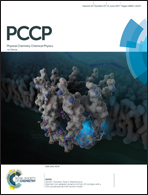Simulation of intermediate transport in nanoscale scaffolds for multistep catalytic reactions†
Abstract
Efficient catalytic cascades that involve several sequential reactions are found frequently in nature. The efficiency of multi-step biochemical pathways is enhanced by substrate channelling, wherein the product of one reaction is directed toward and acts as substrate to the next sequential reaction. Such mechanisms can partially overcome diffusion, which is often fast compared to reaction rates, and promotes loss of intermediates. Biochemical substrate channelling is achieved by the architecture and scaffolding of enzymes, and mimicking these natural structures could lead to innovative catalyst designs. We investigate the efficiency of two channelling approaches – electrostatic interactions and surface adsorption – through continuum modelling, to identify the limits of these modes and the extent to which they can interact. The model considers transport between two active sites where an intermediate is produced at the first active site and consumed at the second. The system includes mass transport through diffusion and migration, and reaction kinetics at the active sites. The effectiveness of this model is quantified by yield of the second reaction relative to the first. Channelling via proximity between active sites and via surface adsorption are found to be inefficient, requiring high values of the rate constant at the second active site to obtain significant yields. The introduction of electrostatic interactions, however, leads to yields of over 90% at much lower values of the rate constant.



 Please wait while we load your content...
Please wait while we load your content...